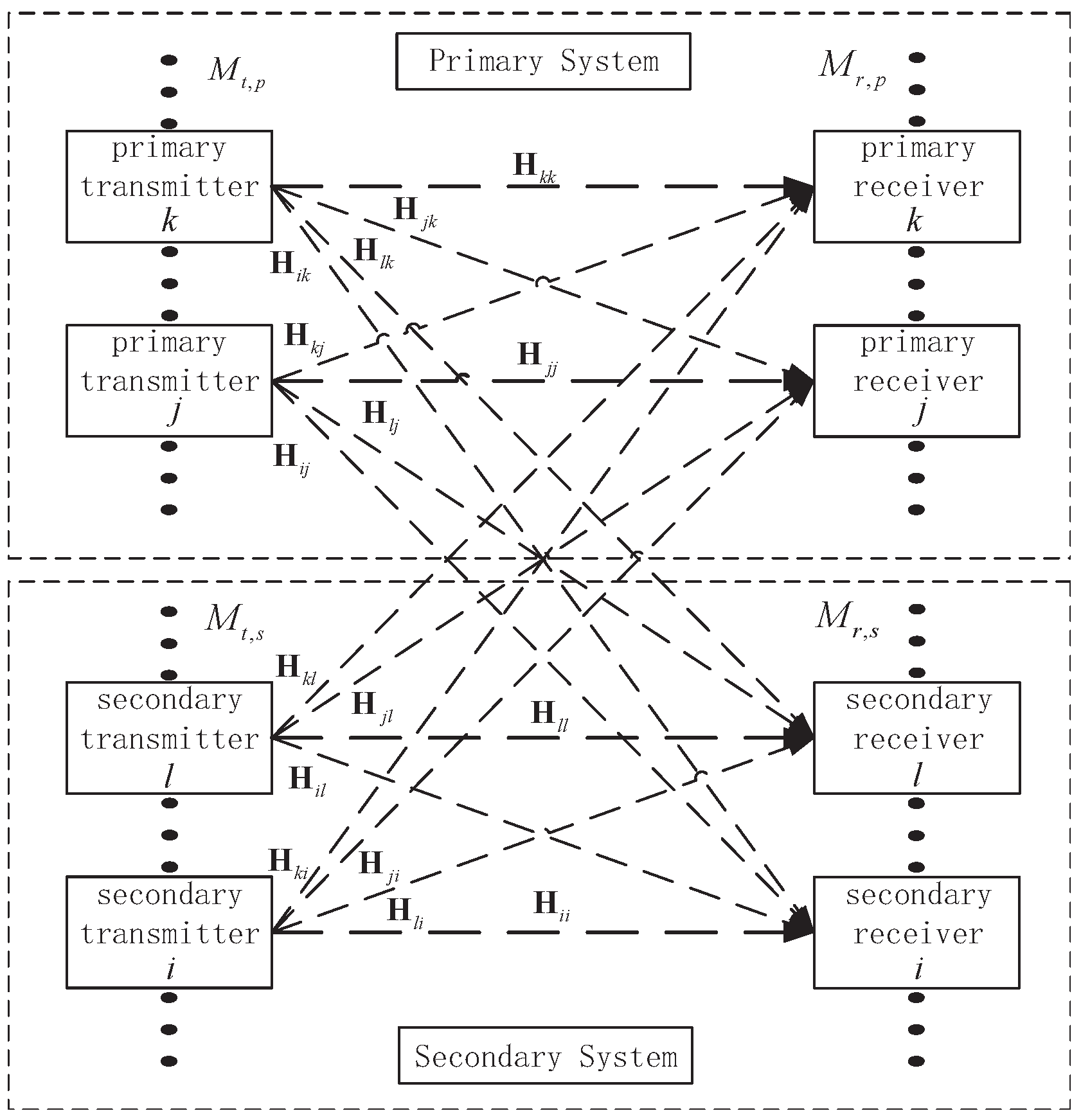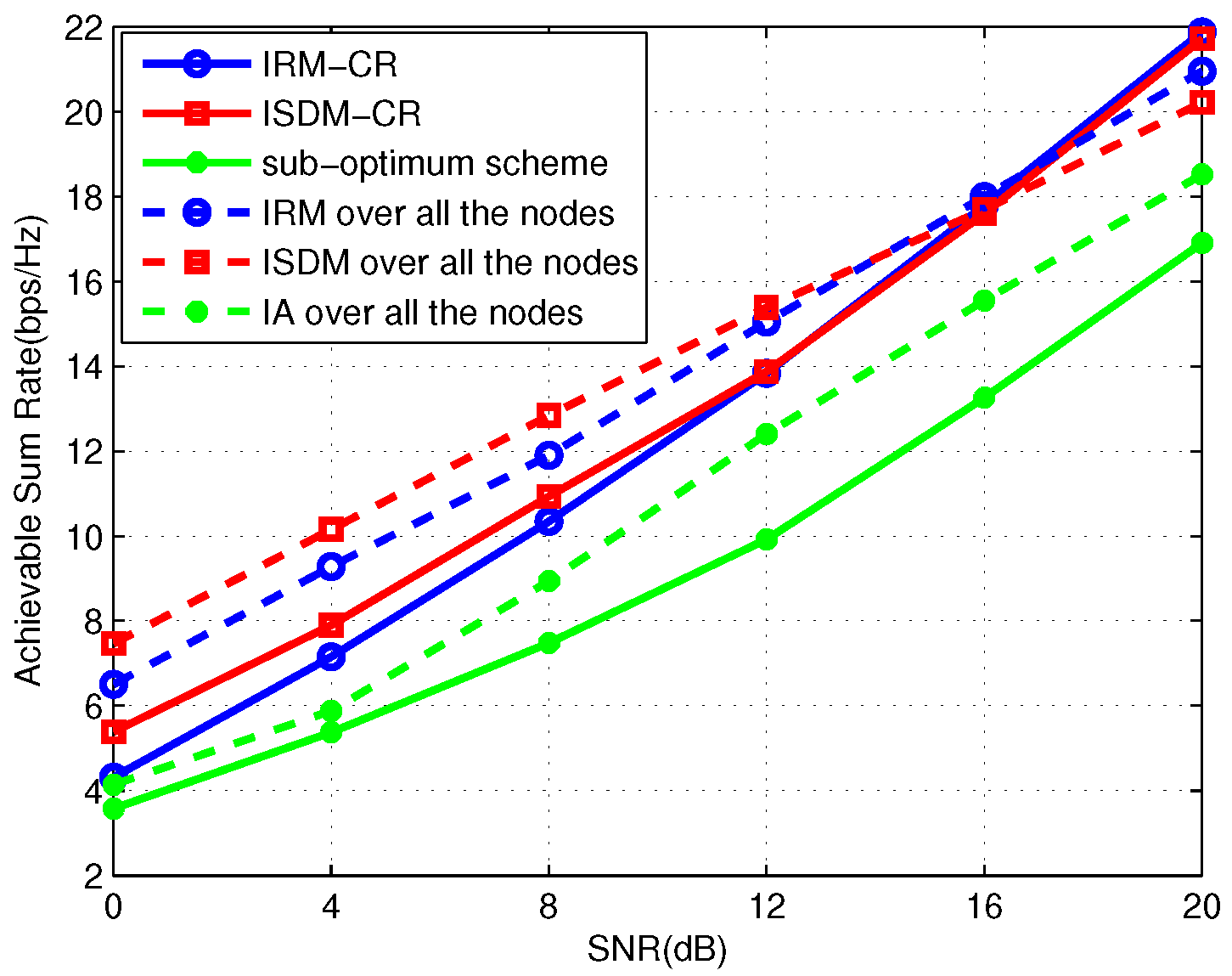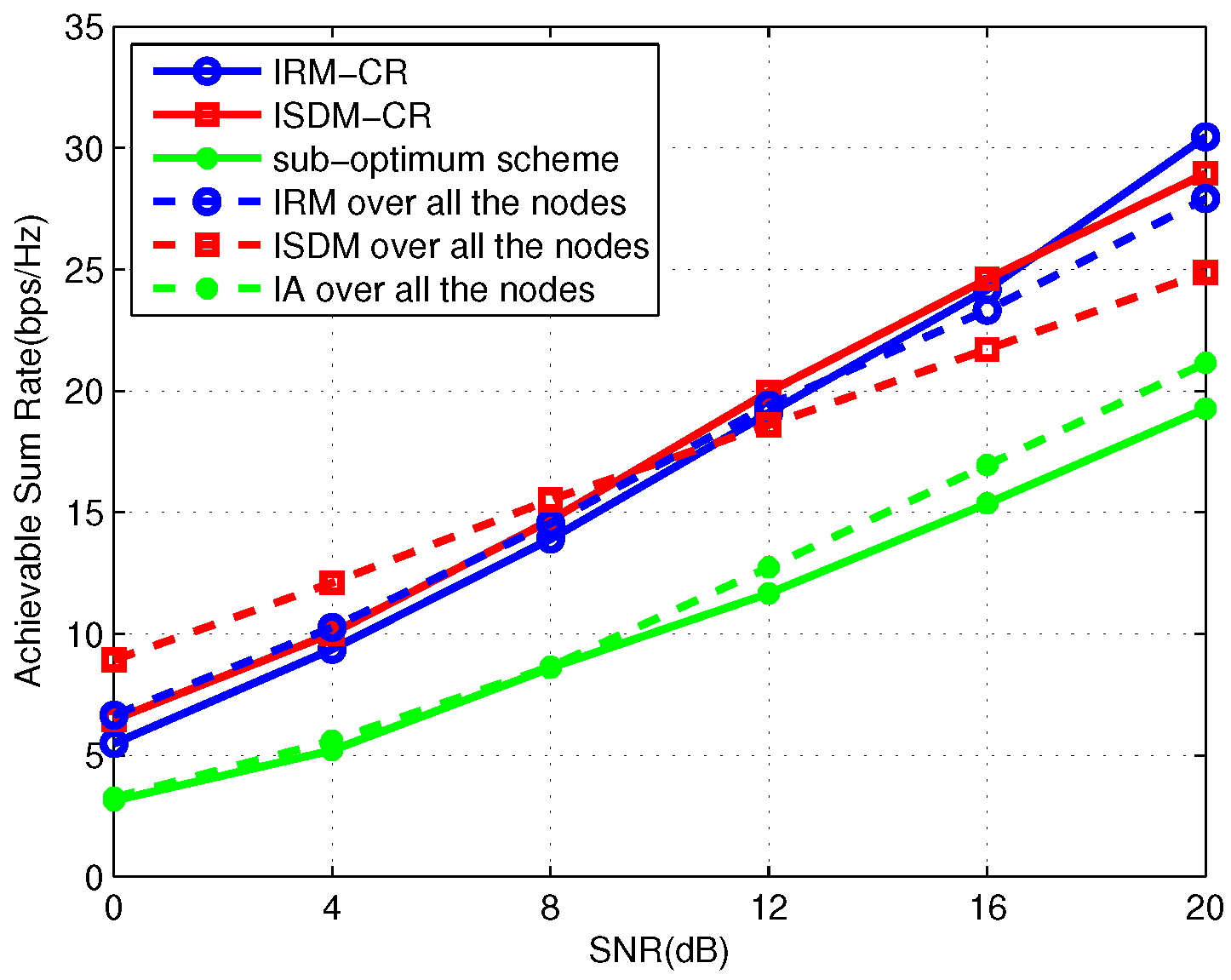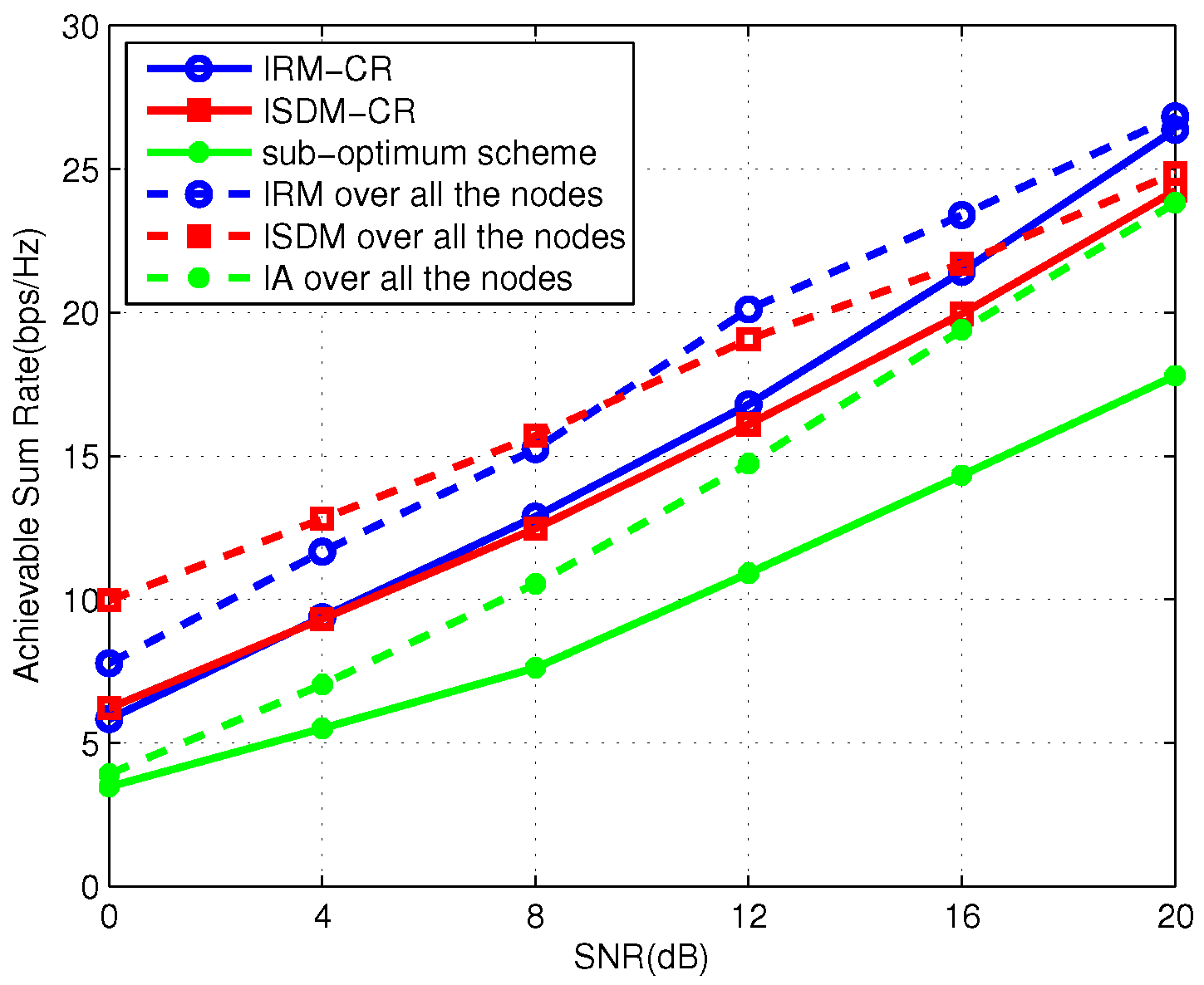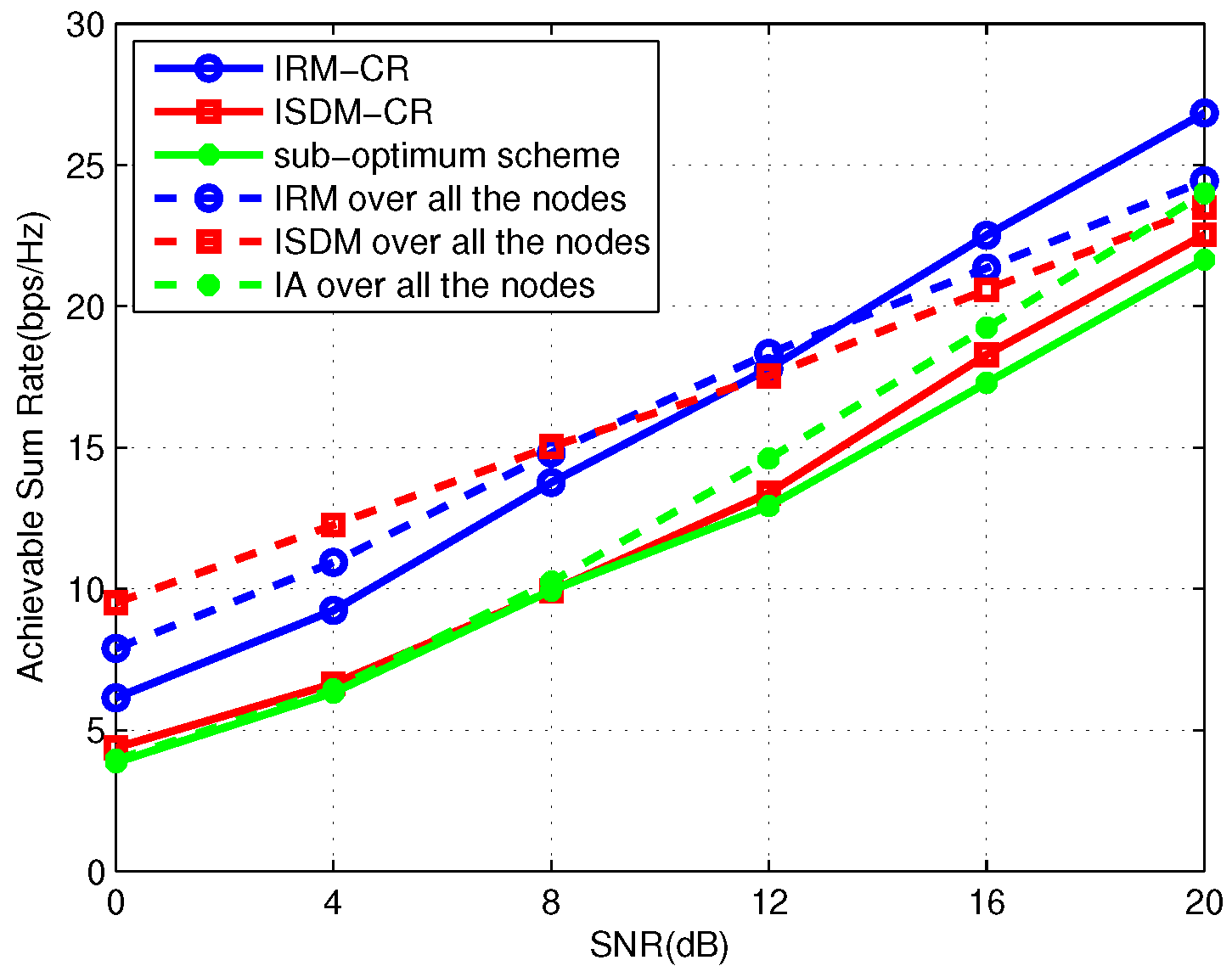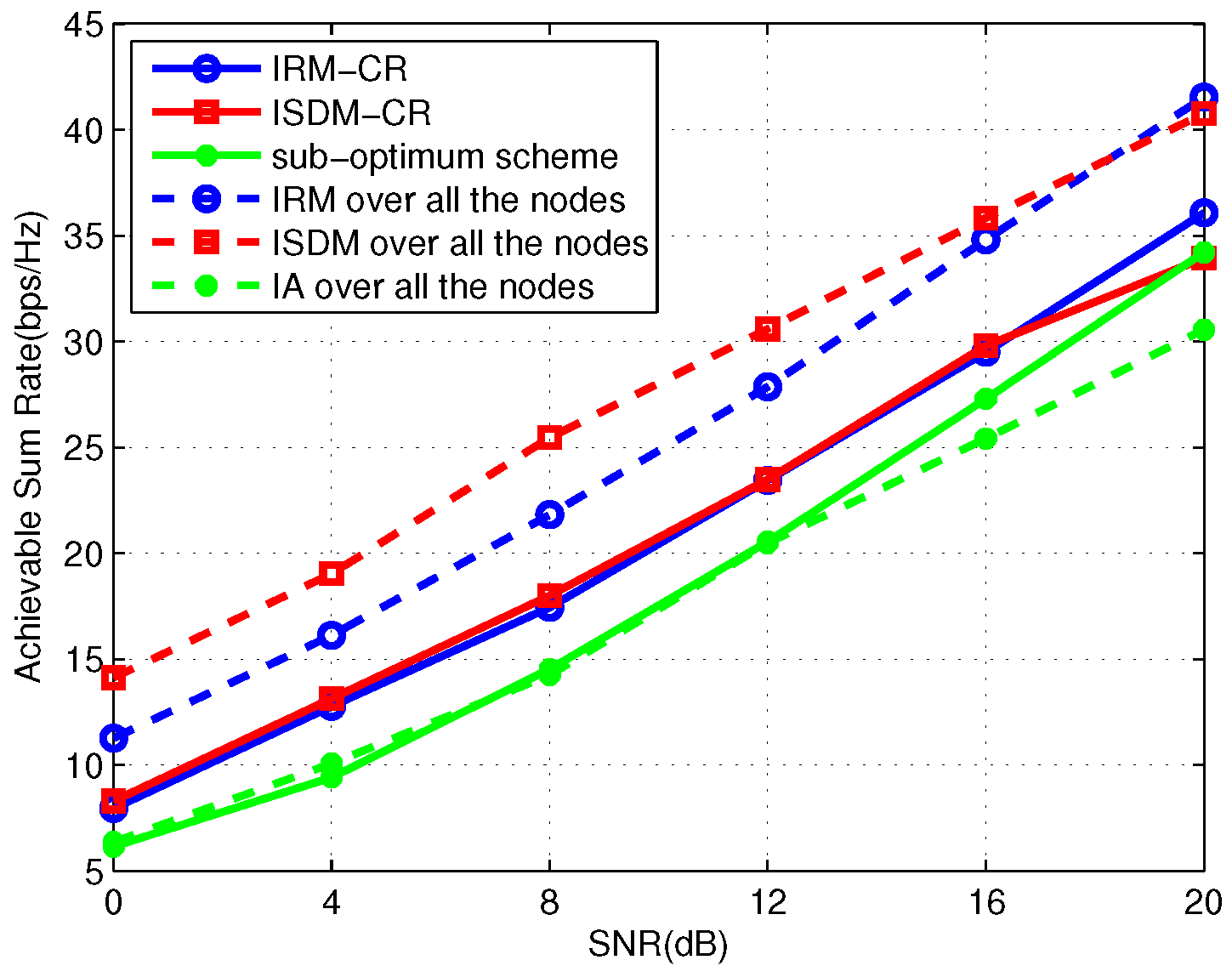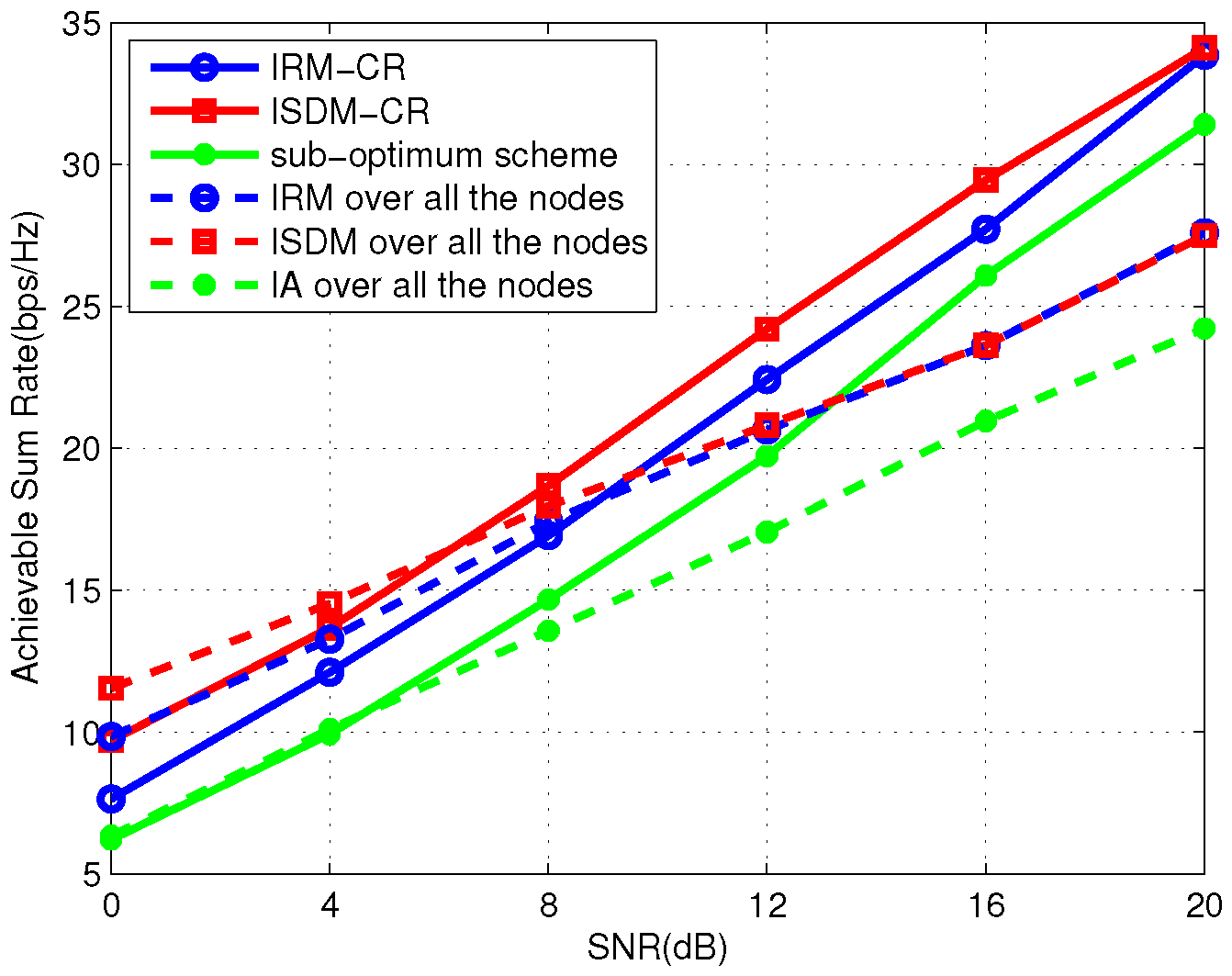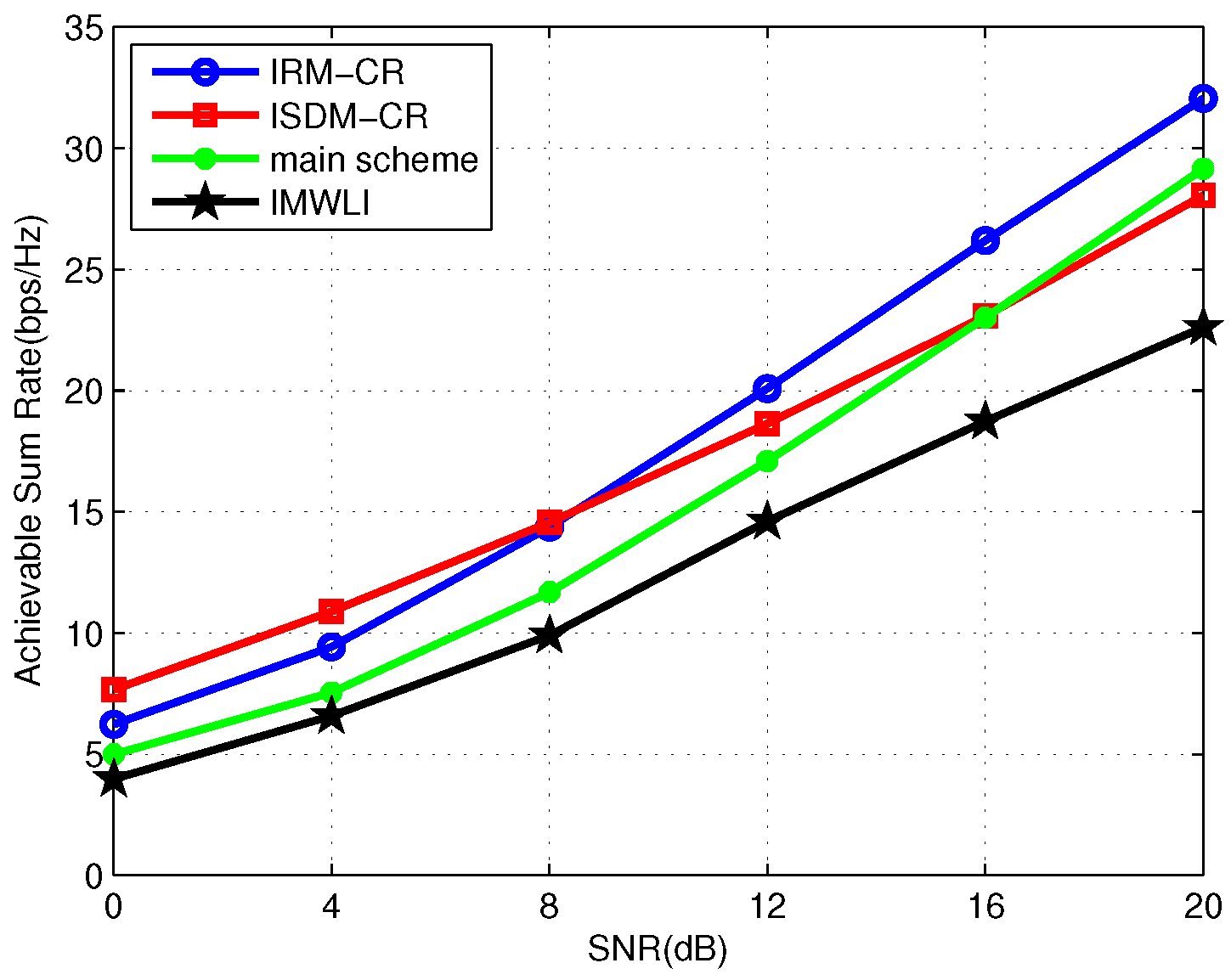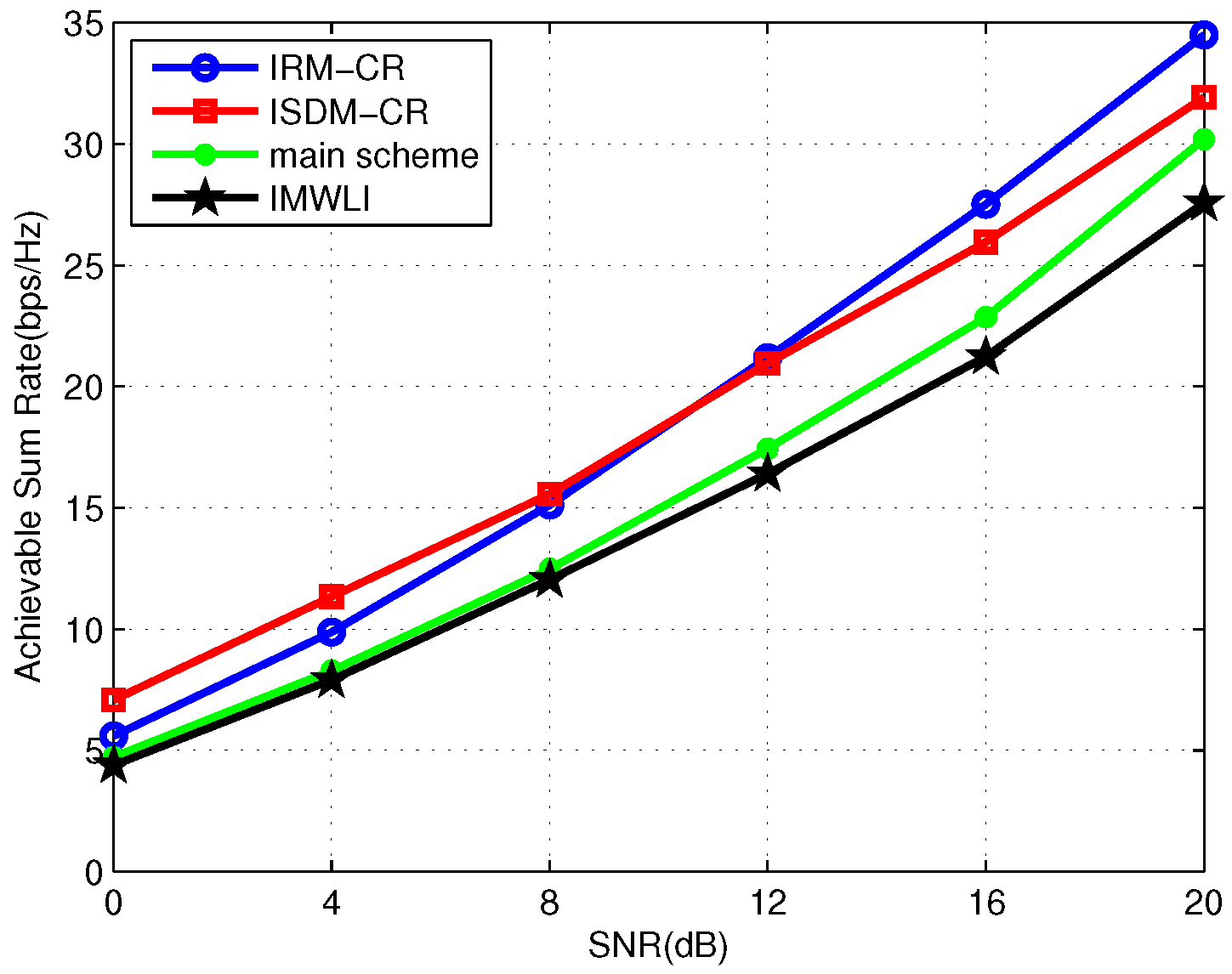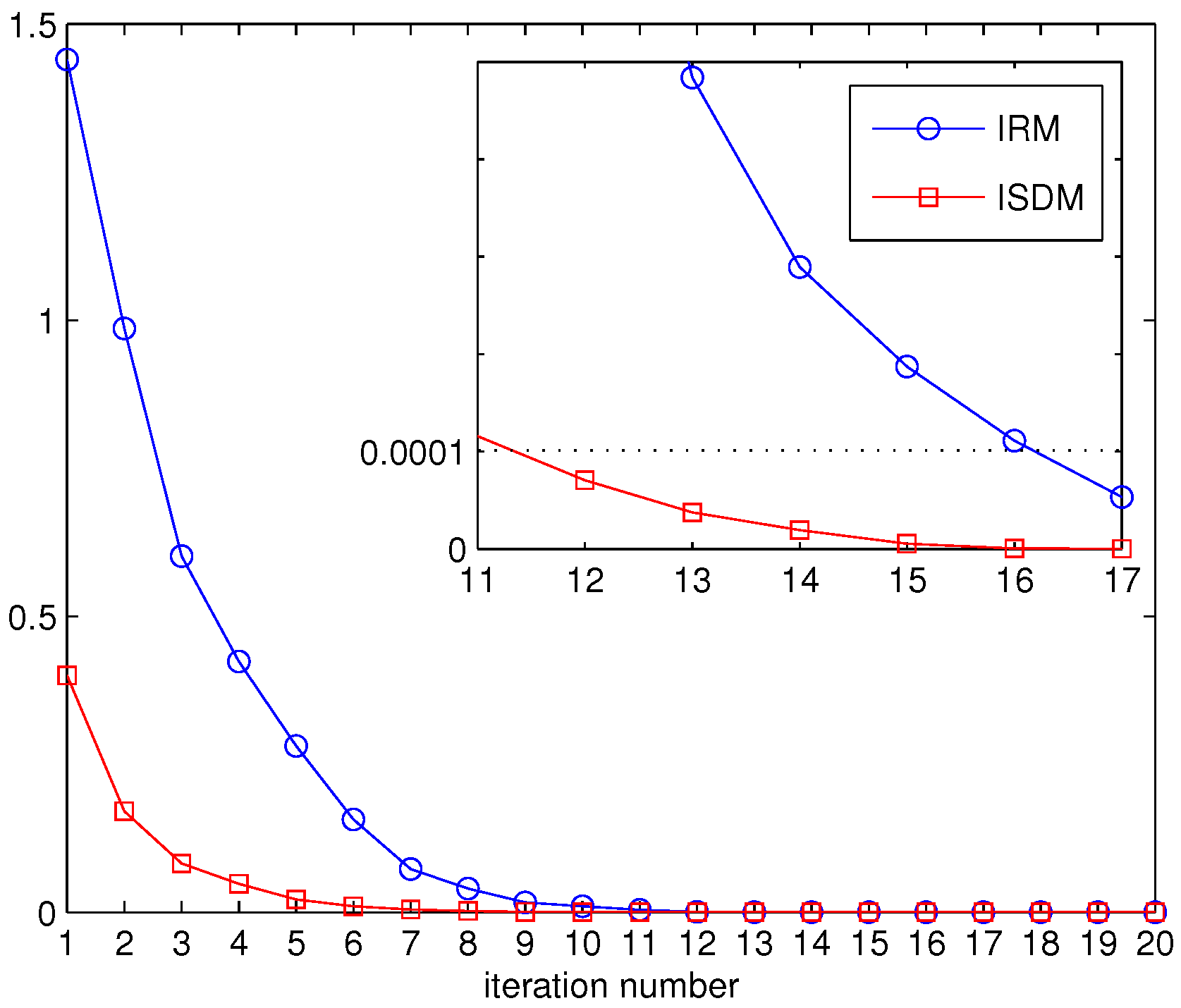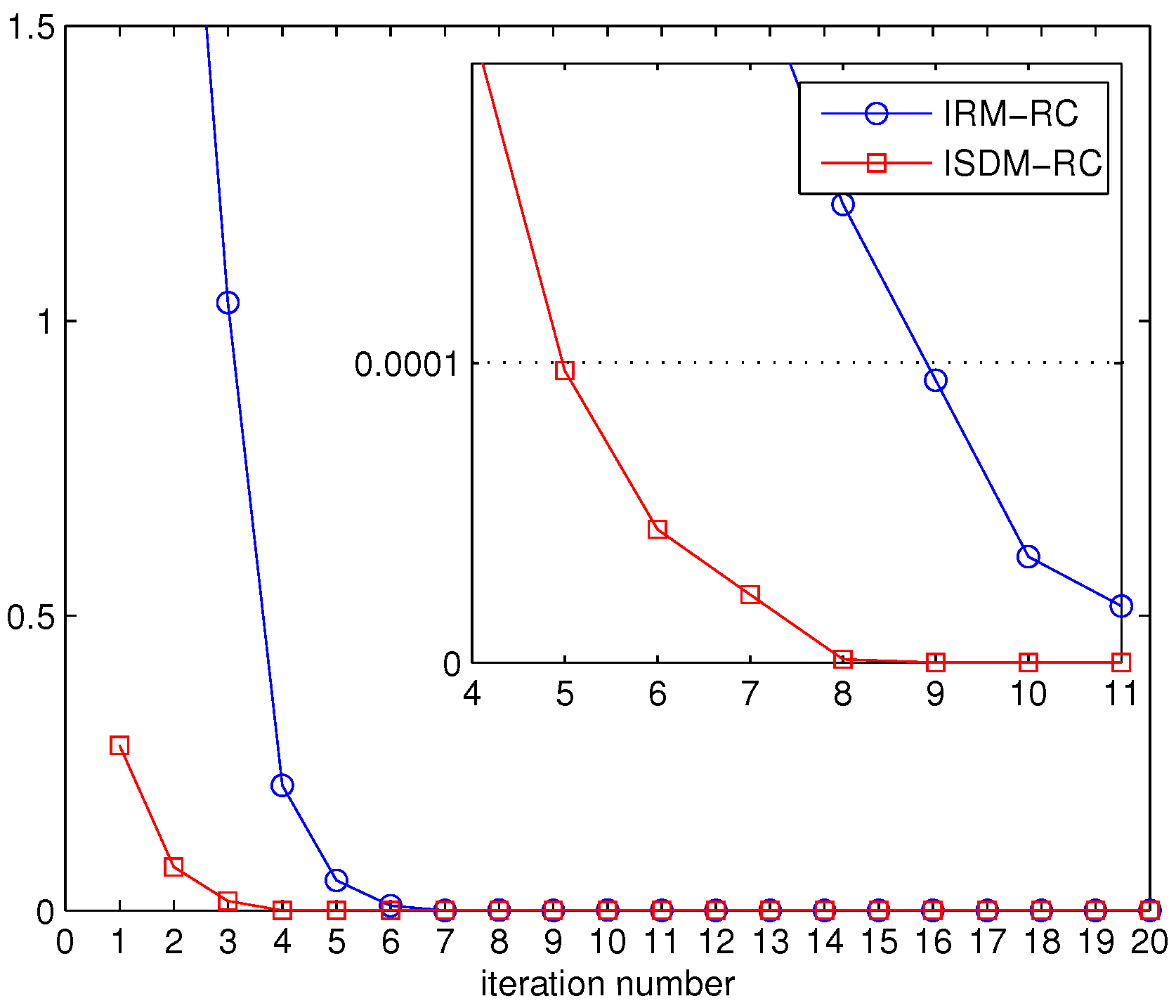1. Introduction
With the rapidly increasing data rate requirements of mobile users for multimedia applications, the accessible radio spectrum is becoming critically scarce. Under traditional fixed spectrum allocation policy, some licensed bands are overcrowded while many others are underutilized. To address this issue, the cognitive radio (CR) concept was introduced to improve spectral efficiency in wireless systems. CR allows secondary users (cognitive users or SUs) to share the spectrum with the primary users (non-cognitive users or PUs) under the condition that SUs do not degrade the performance of PUs [
1,
2]. Dealing with the interference in the CR network is a challenging problem. Recently, an effective interference management scheme called interference alignment (IA) has been exploited to solve the interference problem in CR network [
3].
Interference alignment (IA) is a recent breakthrough in approaching the capacity of interference networks at a high signal-to-noise ratio (SNR). To perform IA, several different algorithms with different properties are proposed. In [
4], an iterative algorithm called interference leakage minimization (MWLI) was presented for the multiple-input multiple-output (MIMO) interference channel, which aimed to minimize the sum of interference power at each receiver. The authors proposed a rank constrained rank minimization (RCRM) in [
5], which minimizes the nuclear norm of the interfering space with a full rank constraint on the desired signal space. Motivated by [
5], a weighted version of nuclear norm minimization for finding the optimal encoders was further presented in [
6]. In contrast to the above algorithms which perform their optimizations via alternating between the forward and reverse communication links, some one-sided algorithms for achieving IA at transmitters only were proposed in [
7,
8,
9]. An IA scheme based on precoder design had been proposed in [
7], where the precoders were chosen to minimize the sum of the smallest eigenvalues of interference covariance matrices over all receivers. In [
8], the authors proposed designing the precoding matrices by minimizing the chordal distances of interfering subspaces. Apart from the above schemes, the feasibility conditions for IA in an interference channel were investigated in [
10,
11,
12] whereby a rapid convergent IA scheme for wireless sensor networks was proposed.
So far, many works have studied applying IA to the CR networks [
13,
14,
15,
16,
17,
18,
19,
20,
21,
22,
23]. In [
13], the author characterized the achievable degree of freedom (DoF) for the secondary network. In [
14], Zhou et al. optimized both the precoding vectors and power allocation to enhance the rates of secondary users, where a gradient method was used. In [
15], under the presumption that the interference imposed by PU at each SU can be neglected, an IA scheme minimizing the distance between the interfering subspace and the received subspace was proposed. The authors of [
16] proposed a maximum eigenmode beamforming (MEB) scheme applied to PUs, where the PU transmits its data only at the largest eigenmode and more unused eigenmodes can be reserved than in the water-filling algorithm. Inspired by [
16], the authors in [
17] proposed an eigenmode constraint with which the number of eigenmodes used by PUs was adaptively adjusted by the rate requirement. In [
18], a space-time opportunistic IA technique was proposed for the overlay CR network, where the PU used space-time water-filling algorithm to optimize its transmission and in the process, freed up unused eigenmodes that could be exploited by the SU. The authors of [
20] proposed an algorithm that enables the secondary transmitter to learn the interference channel of the primary receiver by measuring a monotonic function of the interference to the primary receiver. The authors of [
21] put forward a blind opportunistic IA method with which the SU is able to compute blindly the required channel state information (CSI) without interaction with the primary network. In contrast to the above algorithms concentrating on the CR network with one PU and multiple SUs, the authors of [
22,
23] investigated the interference mitigation for the CR network with multiple PUs and multiple SUs. In [
22], the authors presented an improved version of a minimum weighted leakage interference (IMWLI) algorithm with a much faster convergence rate. Authors of [
23] developed an optimal interference elimination solution when there are sufficient antennas in the secondary links. Compared to the system in which a PU coexists with multiple SUs, the multi-PU CR system needs to deal with more serious interference, in particular the interference between PUs and SUs. The most commonly-used scheme to eliminate the mutual interference between PUs and SUs is by removing some antennas from the SUs’ transmitters and receivers, as proposed in [
22,
23]. Although such an approach allows SUs to transmit their information without causing/receiving any interference to/from the primary links, it demands them to be equipped with more antennas when the number of PUs increases.
In this paper, we focus on the interference management in the CR network with multiple primary links and multiple secondary links. Firstly, we propose two IA algorithms to mitigate the interference among PUs. In a perfect IA scheme, the signals are constrained into the same subspace at the unintended receivers, and thus the desired signal can be recovered by eliminating the aligned interferences. Based on this point, an interference rank minimization (IRM) algorithm, which minimizes the rank of the joint interference matrix via alternating between the forward and reverse communication links, is proposed to reduce the dimensions occupied by the interference signals. Considering the overhead of information exchanged between the transmitters and receivers in the IRM scheme, we develop an interference subspace distance minimization (ISDM) scheme which performs its iteration at the transmitters with the local CSI. The ISDM scheme first introduces the concept of aligned subspace, and then reduces the interference dimensions via aligning the subspaces spanned by interference with the aligned subspace. For the secondary links, though the received interference at secondary receivers can be mitigated through IRM and ISDM, the proposed two IA schemes make no attempt to eliminate the interference from SUs to PUs. Therefore, IRM and ISDM cannot be directly used for the secondary network. To address this, we improve the IRM and ISDM scheme by putting a rank constraint into their optimizations, where the rank constraint forces the rank of the interference matrix from SU to PU to be 0. In this paper, the improved versions of IRM and ISDM for SUs are respectively defined as IRM based on the rank constraint (IRM-RC) and ISDM based on the rank constraint (ISDM-RC). It is worth mentioning that, compared with the commonly used method to eliminate interference from SUs to PUs, our rank constraint need not equip SUs with additional antennas with the increasing number of primary users. Simulation results show the effectiveness of the proposed schemes in terms of the average sum rate. We further validate that the proposed schemes can be applied to the system regardless of whether the antennas of secondary users are sufficient or not.
The rest of this paper is organized as follows.
Section 2 introduces the system model. The details of IRM and ISDM are described in
Section 3.1 and
Section 3.2, respectively.
Section 4 provides the IRM-RC and ISDM-RC schemes for secondary MIMO links. Simulation results are given in
Section 5. The paper concludes in
Section 6.
Notation: Throughout the paper, we use bold uppercase and lowercase letters to denote matrices and vectors respectively. , , , and denote the Hermitian transposition, rank, Frobenius norm, nuclear norm and trace of the matrix , respectively. denotes the distance between the two subspaces spanned by and . denotes a matrix whose columns constitute an orthonormal basis for the orthogonal complement of . is the smallest eigenvalue of . denotes the minimum eigenvalue of . stands for the identity matrix and stands for the null matrix. means is Hermitian positive definite. represents the statistical expectation.
3. Proposed IA Schemes
Since primary users transmit their signals regardless of secondary users, the optimization problem in the primary network can be considered as a standard IA problem, and thus IA schemes can be directly applied to PUs. In this section, we focus on the alignment of the unintended signals for each PU, and two IA schemes aiming to reduce the dimensions occupied by the interference signals are proposed.
3.1. Interference Rank Minimization (IRM)
The space spanned by the interference signals at the
k-th primary receiver is:
According to the matrix theory, the dimension of
can be expressed as
. To reduce the dimensions occupied by the interference signals, the objective for the IRM here can be modeled as minimizing the rank of the joint interference matrix as shown in Equation (
4).
To approach this highly nonconvex and intractable problem in Equation (
4), we use convex relaxations for the objective function [
5]. Thus we have:
where
denotes the convex envelope. The normalized nuclear norm in Equation (
5) is the convex envelope of the rank of the joint interference matrix when the maximum singular value of the joint interference matrices is upper bounded by
[
24]. The optimization problem for the primary system is:
From the optimal solution, the majority of the interference experienced at the
k-th primary receiver falls into the same subspace. Nevertheless, the received signal-to-interference-and-noise-ratio (SINR) could still have significant degradation if the desired signal subspace of the
k-th primary user lies close to the interference subspace. Moreover, the decoder at the
k-th primary receiver would not be completely orthogonal to the aligned interference subspace for the sake of improving received SINR. As a result, there may exist leaked interference power at the
k-th primary receiver. It is enough to only minimize the rank of the joint interference matrix. To address this, we improve the rank optimization in Equation (
6) through two steps:
The first step: We put the constraint on the desired power into the optimization problem.
where
is the minimum desired power requirement.
Considering that the Frobenius norm is convex, we substitute the Frobenius norm in Equation (
7) with the minimum eigenvalue which is concave for a real symmetric or complex Hermitian matrix.
where
is the modified minimum desired power requirement.
The following proves that constraint Equation (
7) can be transformed into constraint Equation (
8).
Proof: We force the desired signal matrix
to be Hermitian positive definite. Using the identity that
and
, we obtain:
Since
is an Hermitian positive definite matrix, its eigenvalues are all greater than zero. Using the Cauchy inequality, we derive:
From
, we have:
☐
The second step: We improve the optimization problem in Equation (
6) with a weighted optimization in order to mitigate the leaked interference power.
where
(
) stands for the weighted value.
In view of the above two steps, we reformulate the optimization problem to a constrained one.
In this paper, we define:
The logical flow of the IRM algorithm is given as follows::
Set and , start with arbitrary decoding matrices ;
Calculate
, according to Equation (
3);
If , go to Step 5. If not, set , go to Step 2;
Orthogonalize .
3.2. Interference Subspace Distance Minimization (ISDM)
Though IRM can effectively improve the system performance, its pre- and post-processing filter design needs to alternate between the forward and reverse communication links. Considering the overhead of information exchanged between the transmitters and receivers in the IRM scheme, we develop an interference subspace distance minimization (ISDM) scheme which runs at the transmitters only.
To reduce the interference dimensions at all receivers, one of the achievable methods is to minimize the sum of subspace distances between different interfering signals over all receivers. Since the total spatial distances in such an approach are approximate to , there exist excessive spatial distances to be optimized with the number of users increasing. To solve this problem, this paper introduces the concept of aligned subspace and reduces the interference dimensions via aligning the subspaces spanned by interference with the aligned subspace. It is not difficult to find that the spatial distances needed to be optimized in ISDM are approximate to at each transmitter.
Lemma 1. Assume that there is a matrix and a linear subspace spanned by . According to the matrix theory, the orthogonal projection of onto the subspace spanned by is . Thus, the sum of the squared Euclidean distances between the columns of and their orthogonal projections onto the subspace spanned by can be expressed as .
We define
as the
k-th primary aligned matrix, whose columns span the
k-th aligned subspace. Using lemma 1, the total sum of the spatial distances between the interference subspace and the aligned subspace in the secondary network is:
From
, Equation (
15) can be expressed as:
To solve the optimization problem in an iterative fashion, we first calculate
. Intuitively, when taking
as the variable, the items related to
in Equation (
16) are:
According to the matrix theory,
The optimal solution to the objective function in Equation (
18) is:
where
denotes the
least significant eigenvectors of
. Obviously, the calculation of
can be only taken at the
k-th transmitter node with local CSI.
Similarly, if we take
as the variable, the items related to
in Equation (
16) are:
Note that the optimization problem in Equation (
20) mitigates the interference on the undesired receiver while ignoring the distance between two subspaces spanned by the desired signal matrix and the aligned matrix. To alleviate this drawback, we put the constraint on the desired power into the optimization, which is similar to the method adopted to IRM:
Considering the precoders design is taken at the transmitters only, we substitute with columns of .
We reformulate the precoding matrix optimization problem as:
Note that the calculation of
is also taken at the
j-th primary transmitter with local CSI. In this paper, we define:
The logical flow of the precoders design in the ISDM algorithm is given as follows:
Set and , start with arbitrary ;
Calculate
according to Equation (
19);
At the j-th primary transmitter,
If , go to Step 5. If not, set , go to Step 2;
Output: .
The receive filters have been totally excluded from the optimization problem so far. In the following, we illustrate the calculation of decoders. A sub-matrix optimization method is employed to design the primary decoders, where the primary decoding matrix is divided into two sub-matrices (). The first sub-decoder manages the interference from other PUs while the second sub-decoder improves the received desired signal power.
After achieving the optimal precoders, the subspaces spanned by interference from other PUs are almost aligned with the subspace spanned by the aligned matrix. We choose the orthogonal complement of as the first sub-decoder .
The intended signal power at the
k-th primary receiver is:
In order to maximize the intended signal power, the columns of are chosen as the eigenvectors corresponding to the most significant eigenvalues of .
5. Simulation
In this section, we provide some simulation examples to evaluate the performances of the proposed algorithms. The secondary system is represented by
. In this paper, if
and
satisfy:
the secondary system is defined as an “adequate antennas system”; otherwise, the secondary system is defined as an “inadequate antennas system”. Simulation results are averaged over 500 channels. The noise power is normalized to one.
equals to 0.1 [
5].
is 0.02 [
6]. The optimization problems proposed in this paper are all solved by the CVX toolbox [
25]. In the following, we first evaluate and compare the performance of the interference rank minimization in the CR network (IRM-CR) and interference subspace distance minimization in the CR network (ISDM-CR). sub-optimum scheme proposed in [
23], “IRM over all the nodes”, “ISDM over all the nodes” and “IA over all the nodes” in the “inadequate antennas system”. IRM-CR means using IRM for PUs and IRM-RC for SUs. Similarly, ISDM-CR means applying ISDM to the primary network and ISDM-RC to the secondary links. The algorithm to deal with interference in the “inadequate antennas system” proposed in [
23] is represented as a sub-optimum scheme. “IRM over all the nodes” means all the users are cooperating through the IRM IA schemes. Similarly, “ISDM over all the nodes” denotes all the users are cooperating through ISDM. “IA over all the nodes” means all the users are cooperating through the MWLI algorithm.
In
Figure 2,
Figure 3 and
Figure 4, a symmetric three-user primary system with 4 transmit antennas and 2 receive antennas is considered, where each PU demands one DoF. We simulate the average total sum rate of the primary and secondary links where the secondary system is
in
Figure 2. As seen from the figure, the performance of IRM-CR is lower than that of ISDM-CR in the low SNR region, whereas it increases gradually and approaches the ISDM-CR curve when SNR is greater than 12 dB. Though IRM-CR achieves the same rate as ISDM-CR for SNRs greater than 12 dB, ISDM-CR is still considered to be superior to IRM-CR due to the one-sided precoders design in ISDM-CR. According to [
23], the secondary precoding matrices design in the sub-optimum scheme only aims to mitigate interference from SU to PUs. For a system with multiple secondary users, it is very difficult to align the interference signals processed by the precoding matrices in the sub-optimum scheme into the same space direction. As a result, the interference among SUs can lead to poor performance of the secondary system, as confirmed through simulation.
Observing
Figure 2, for SNRs lower than 16 db, “IRM over all the nodes” and “ISDM over all the nodes” respectively achieve a higher sum rate compared with IRM-CR and ISDM-CR. This is because PUs in the IRM-CR and ISDM-CR schemes design their pre- and post-processing matrices without any cooperation with SUs, whereas all the users are cooperating through IA in “IRM over all the nodes” and “ISDM over all the nodes”. Furthermore, SUs are constrained by the condition in Equation (
26). Nevertheless, with the SNR increasing, IRM-CR and ISDM-CR respectively outperform “IRM over all the nodes” and “ISDM over all the nodes”. As know, SUs are treated fairly in “IRM over all the nodes” and “ISDM over all the nodes”, whereas they are treated unfairly in IRM-CR and ISDM-CR due to the fact that the primary network dominates in the CR network. Thus, the significant improvement of the IRM-CR and ISDM-CR schemes is attributed to the reduction of user fairness. Furthermore, it can be also observed that the performance improvement at the expense of user fairness reduction becomes more obvious with the SNR increasing.
Figure 3 and
Figure 4 simulate the average total sum rate of the primary and secondary links where the secondary system is
and
, respectively. Observing the two figures, under the same preexisting primary links, IRM-CR outperforms ISDM-CR by over 16 dB in the two-user secondary system and 4 dB in the three-user secondary system. It can be inferred that IRM-CR is superior to ISDM-CR when the number of SUs increases. In
Figure 5, we consider a symmetric four-user primary network with four transmit antennas and two receive antennas. Each PU demands one DoF. The secondary system is
. The transmission rate in the IRM-CR scheme is about 5 bps/Hz higher than ISDM-CR. Compared with
Figure 3, it can be inferred that the increase of primary users can significantly influence the performance of the secondary links when applying ISDM-CR.
We consider a symmetric three-user primary system with
antennas. Each PU demands two DoF.
Figure 6 gives the average total sum rate of the primary and secondary links where the secondary system is
. Under the same antenna configuration,
Figure 7 displays the result that all SUs achieve two DoFs. Observing
Figure 6, IRM-CR and ISDM-CR present a similar performance for SNRs, of lower than 16 db. As shown in
Figure 7, the ISDM-CR scheme benefits from higher transmission rates compared with the IRM-CR approach. From these two figures, it is clear that ISDM-CR is more effective to mitigate interference than IRM-CR with an increasing number of DoFs.
In the following, we investigate the performance of IRM-CR, ISDM-CR in the “adequate antennas system”. Moreover, the main scheme proposed in [
23] and the IMWLI algorithm are also considered, where the algorithm proposed by [
23] to manage interference in the “adequate antennas system” is denoted as the main scheme. A symmetric three-user primary system with
antennas is considered in
Figure 8 and
Figure 9, where each PU demands one DoF. Different from the above simulations, the two SUs in
Figure 8 and
Figure 9 are equipped with different antennas: the first one with five transmit/receive antennas and the second one with seven transmit/receive antennas.
In
Figure 8, the first SU demands two DoFs while the second SU transmits one data stream. It can be seen that the ISDM-CR scheme has the best performance at the low SNR region while IRM-CR outperforms ISDM-CR with the SNR increasing. IMWLI achieves the worst performance. The sum rate achieved by the main scheme is higher than ISDM-CR when SNR is greater than 16 dB. According to [
23], for a two-user secondary system, the first SU can maximize its data rate without degrading the performance of the PUs and receive harmful effects from the primary system if:
The second SU is able to transmit its data streams without causing/receiving any interference to/from the preexisting users (PUs and the first SU), as well as improve its performance if:
Based on Equation (
41), it is clear that the first SU can eliminate the received interference. According to Equation (
42), the second SU can maximize its data rate while eliminating the interference imposed by the preexisting users. Therefore, the main scheme performs well when the performance is dominated by interference. The average total sum rate of the primary and secondary links where all the secondary users achieve two DoFs is shown in
Figure 9. Observing
Figure 9, ISDM-CR achieves the best performance at the low-SNR region while IRM-CR benefits from higher transmission rates compared with the other three approaches. Since there are not enough antennas for secondary users to optimize their links, the performance obtained by the main scheme is poor in
Figure 9.
From
Figure 2,
Figure 3,
Figure 4,
Figure 5,
Figure 6,
Figure 7,
Figure 8 and
Figure 9, it can be observed that IRM-CR outperforms ISDM-CR with the SNR increasing. Here, we analysis the reasons for the significant performance improvement of IRM-CR. One of the reasons is that the “rank minimization” in IRM-CR is a more straightforward method to increase the achievable DoFs which is important to improve the system performance in the high-SNR region. Besides, IRM-CR minimizes the interference signals power, which further mitigating the impact of interference.
With the consideration of a number of parameters, the Cost-231 Walfisch-Ikagami model allows an excellent path loss model to explain the characters of an urban area. This model is appropriate for frequencies 800 MHz to 2000 MHz and distances ranging from 0.02 km to 5 km [
26]. The path loss of this model is defined as:
where
d and
f respectively denote the distance in km and the frequency in MHz.
Figure 10 gives the average total sum rate of the primary and secondary links where the Cost-231 Walfisch-Ikagami path loss model is used to estimate the path loss of the interfering links (PU-to-SU, SU-to-PU). We consider a symmetric three-user primary system with
antennas. Each PU demands two DoF. The secondary system is
. We can observe that the rate gets higher with the distance increasing under the large path loss environment. From the figure, the achievable rate is the lowest when the interfering links (PU-to-SU, SU-to-PU) have no large path loss, especially, when the performance is dominated by interference. However, the degradation of the rate without path loss is no more than 3 bps/Hz. We can infer that the proposed schemes can well eliminate the interference between the PU and the SU. Though the performance achieved by IRM-CR is higher than that of ISDM-CR, the ISDM-CR scheme is less sensitive to the path loss compared with the IRM-CR scheme.
The previous figures show that the CR network achieves superior performances by applying proposed algorithms. We further evaluate the convergence of the proposed algorithms in
Figure 11 and
Figure 12. A primary network consisting of three primary users with
antennas and a secondary network comprised of two secondary users with
antennas are considered. Each user in the CR network demands two DoFs. In this paper, we focus on the difference of the objective function between two adjacent iterations. The convergence threshold is given as
. Here, SNR = 15 dB.
Figure 11 evaluates the convergence of IRM and ISDM. It can be seen that the difference of the objective function between the 11th and the 12th iteration is no more than 0.0001 in the ISDM scheme, whereas IRM needs 17 iterations to realize the objective function difference below 0.0001. In
Figure 12, the convergence of IRM-RC and ISDM-RC is investigated in the presence of the primary network. To achieve the goal that the objective function difference between two adjacent iterations is lower than 0.0001, the IRM-RC approach needs nine iterations while the ISDM-RC requires five iterations. Observing
Figure 11 and
Figure 12, it is clear that the “spatial distances minimization” scheme converges faster than “rank minimization” scheme.
